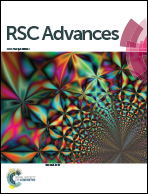Beneficial effects of biomimetic nano-sized hydroxyapatite/antibiotic gentamicin enriched chitosan–glycerophosphate hydrogel on the performance of injectable polymethylmethacrylate
Abstract
Injectable polymethylmethacrylate (PMMA) bone cement is a widely used bone substitute in cemented arthroplasty, vertebroplasty and osteoporosis fractures. However, due to the inappropriate stiffness, poor bioactivity and high polymerization temperature of PMMA, aseptic loosening of the implanted cement at the bone–cement interface still could be observed in a high rate of patients. To improve the performance of PMMA, artificial extracellular matrices like chitosan–glycerophosphate (CS–GP) thermosensitive hydrogel was introduced into PMMA acting as a pore forming agent and osteoconductive nano-sized hydroxyapatite (nano-HA)/antibiotic gentamicin (GM) as a carrier. It is shown that CS–GP thermosensitive hydrogel can effectively create open pores at the surface of the PMMA cement, which is believed to facilitate bone tissue ingrowth and improve the cement anchorage at the bone–cement interface in future clinical applications. Meanwhile, such a hydrogel effectively decreases the maximum polymerization temperature to below 30 °C, prolongs the working time to more than 720 s and produces cement with a proper modulus of elasticity and a compressive yield strength ranging from 402 to 584 MPa and from 3.1 to 5.9 MPa, respectively. Furthermore, the incorporated nano-HA particles sufficiently increase the mineralization capacity of the cement without compromising its mechanical properties and the incorporated GM remarkably enhances the anti-bacterial activity of the cement. More importantly, nano-HA and GM enriched CS–GP thermosensitive hydrogel effectively improve the overall performance of PMMA cement without influencing the cell survival, suggesting the injectable p-PMMA/CS–GP/nano-HA/GM cement will hold strong promise for future bone reconstruction applications.


 Please wait while we load your content...
Please wait while we load your content...